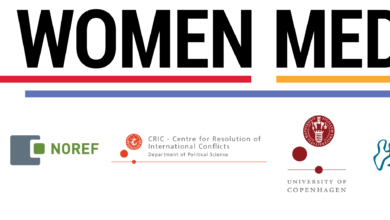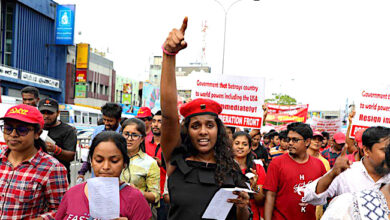The female face of Belarusian resistance – Democracy and society

The Belarusian protest wave of 2020 has often been referred to as ‘a revolution with a female face’. While the public role of women since the end of the protests has diminished, women remain active drivers of resistance, though often operating in the background.
‘Revolution with a female face’, ‘female trio of the Belarusian revolution’ and ‘from housewife to presidential candidate’ – these storylines, describing the Belarusian large-scale protests, headed the foreign media’s front pages in the summer of 2020. Even though often labelled as a women’s protest, the messages of female protestors were aligned with the united demands of Belarusian protesters more generally. To put it shortly; its female face has not automatically made the revolution a feminist one – at least not yet.
At the same time, charismatic women leading the political opposition, female marches against police violence, and numerous female detainees have put the stories of Belarusian women and their trauma, at the forefront of the worsening political situation in Belarus.
Where is the ‘female trio’ today?
When Sviatlana Tsikhanouskaya stood up for her detained husband and became a presidential candidate during in the 2020 election, doubts about her chances to outrun Lukashenka were present both within the opposition and the authorities. Despite the doubts, Lukashenka made a fatal mistake in letting Tsikhanouskaya campaign in the first place. Protest sentiment and anti-governmental grievances within the Belarusian society worked against Lukashenka and in favour of Tsikhanouskaya, as many Belarusians turned to support her as the united opposition’s candidate.
By then, the faces of Maryia Kalesnikava, heading the headquarters of the already imprisoned Babaryka, and Veranika Tsapkala, the wife of the unregistered candidate Valery Tsapkala, were also familiar to most Belarusians. The stories of the three women standing up for their spouses during the political campaigning quickly became a focus of many media outlets, especially after they announced their unification into the so-called ‘female trio’.
Just days after the election, Tsikhanouskaya was pushed out of the country. Something similar happened to Kalesnikava, who was driven to the border with Ukraine and threatened with prison unless she crosses the border. But Kalesnikava tore the authorities’ plan apart – together with her passport. Since the summer of 2020, Tsikhanouskaya and Tsapkala are in exile, while Kalesnikava was sentenced to 11 years in prison.
Belarus is gradually incorporating features of totalitarian regimes in all spheres – with dire impacts on female activists in the country.
Tsikhanouskaya continued her political path in Lithuania, which granted her official diplomatic status. Since 2020, she has met with numerous leaders of democratic countries and talked at the UN, OSCE, the Munich Conference and the European Parliament, continuing to pursue her role as a leader of the democratic forces. In August 2022, she created the United Transitional Cabinet; the Coordination Council created upon her call in 2020 remains active, having gone through reform and expansions. Her story of the ‘housewife’ turning into a solid politician with a busy schedule and turbulent political agenda still catches the attention of the international community and her loyal electorate.
Against this background, the Belarusian regime, which has managed to preserve its power, is gaining more and more control over civil society through the harshest- and unprecedented repression. The number of political prisoners has grown to 1,463 people; out of which 544 are women. Independent media is mostly wiped out in the country. Law enforcement services have advanced their surveillance strategies and tools. This has led to the identification of protest participants via photos published on social media, as well as detentions of those Belarusians who return to the country, even years after participating in the 2020 protests. Hence, overall, Belarus is gradually incorporating features of totalitarian regimes in all spheres – with dire impacts on female activists in the country.
The unseen faces of the female resistance
The ‘female trio’ became a public face of oppositional politics in 2020. At the same time, those hundreds and thousands of Belarusian women that were organising and participating in female marches remained unknown to the general public. Journalists and bloggers that were covering the development of political protests suffered from repression along with female politicians and male colleagues. Katsiaryna Andreeva, Darja Chultsova, Katsiaryna Barysevich, Maryna Zolatava, Kseniia Lutskina and other prominent journalists were sentenced to prison. Similar things happened to activists such as human rights defender Nasta Lojka and those who expressed their position against the war in Ukraine, such as singer Maryam Herasimenka, who was sentenced to three years of house arrest for publicly performing a song of a Ukrainian band.
So far, hundreds of female activists have been forced into exile, where they continue engaging in cultural, political, journalistic and educational projects. Many others remain in the country but do not dare to express their position openly. These are often the wives of political bloggers, activists of union movements and other political prisoners. They remain in the country to visit their husbands and to send food supplies and medicines when allowed – and in some cases, they, too, get arrested just shortly after their husbands, such as in the case of Darja Losik, the wife of the political blogger Ihar Losik.
The public role of women in the Belarusian resistance has diminished along with the rise of totalitarianism within the Belarusian political system. Women continue to engage in secure forms of resistance, serve their criminal sentences for their political position or support their relatives behind bars. But in these conditions, they simply have no space for being the driving engine behind the Belarusian resistance. Moreover, in times when resistance in Belarus takes shape in partisan actions such as an attack on the Russian plane in Machulishcy, women’s activism along with other silent forms of resistance becomes less visible.
Women in exiled pro-democratic movements
Yet, despite the harsh conditions inside Belarus, there is an increased number of female figures within the exiled Belarusian democratic movement who have joined political organisations or who have deanonymised themselves during the last two years.
With an increased normalisation of the presence of Belarusian women in oppositional politics and activism, we should also expect a rise of women’s rights demands on the political level.
The presence of these and other women in politics and media has impacted public discussions on the place women have in politics and within structures of the Belarusian opposition. In an attempt to respond to the public demand to increase the presence of women in the democratic opposition, political structures have appointed more and more women. Some of these appointments were regarded as an attempt to simply fill the gender gap, as in the case of Tatsiana Zaretskaya. However, later appointments by the United Transitional Cabinet such as those of Alina Koushyk and Volha Harbunova were accepted by civil society. Together with their male counterparts and Tsikhanouskaya, they attend international meetings and visit Ukraine to communicate their message of a democratic Belarus.
With an increased normalisation of the presence of Belarusian women in oppositional politics and activism, we should – in the long term – also expect a rise of women’s rights demands on the political level. But for the time being, the political struggle for Belarusians in exile as well as the geopolitical context in the region creates a challenging environment for the further development of women’s rights activism.
Read More



